Installation features
When building from honeycomb plastic, it is recommended to take into account its properties and follow the installation rules:
- The stiffeners of the panels are placed vertically. Condensate that accumulates inside the ducts must flow freely to the outside. If this is not foreseen, water trapped in the cells will break the thin walls of the material during freezing.
- A gap is left between the sheets for thermal expansion. Since the polycarbonate increases in linear dimensions when heated, the lack of free space leads to the destruction of the panel.
- Holes for fasteners are drilled 2 mm wider than the diameter of the bolt or self-tapping screw. This measure is necessary to compensate for changes in the size of the plastic due to temperature fluctuations.
- Do not use excessive force when fastening the sheets. Thin partitions are damaged when screwing in self-tapping screws with pressure. Over time, moisture, insects and fungi continue to break down, leading to premature deterioration of the material.
Although cellular polycarbonate panels are considered strong and durable, improper installation can significantly reduce their lifespan.
What and how to cut
When cutting material, the main danger is crushing and damage to the edges of the cut with a tool, therefore, a hacksaw cannot be used for processing polymer.
A high-quality smooth edge is formed when cutting:
- a clerical or construction knife;
- angle grinder ("grinder");
- jigsaw;
- a hacksaw for metal;
- circular saw.
For professional purposes, they use CNC milling machines, laser equipment.
Work on cutting polycarbonate is carried out in the following sequence:
- A drawing of a polycarbonate gazebo is carried out on paper to scale.
- A smooth sheet is laid on a clean and level area - plywood, chipboard, fiberboard.
- The plastic panel is placed on the base with the laminated, mirror or UV coating facing up. The film is not removed until the end of cutting.
- Transfer the markup from the drawing to the polymer sheet. Use a tape measure, ruler and marker.
- Place boards with a thickness of 40 mm along the cutting line on both sides of the trim. They will act as props and prevent the substrate from being cut through.
- With a sharp tool, cut out the material using a rule or a ruler.

A construction knife or scissors is used to process sheets up to 6 mm. Thicker panels are cut with a more powerful power tool at high speeds. First you need to practice on unnecessary scraps. When working with a grinder or jigsaw, wear protective goggles. It is advisable to remove chips from the channels with a vacuum cleaner with a narrow nozzle before installation.
How to fix
When building a polycarbonate gazebo with your own hands, you need to properly prepare the panels:
- follow the location of the stiffeners - vertically with a pitched roof, parallel to the bends - in an arched roof;
- fix protective sealing tapes on the edges;
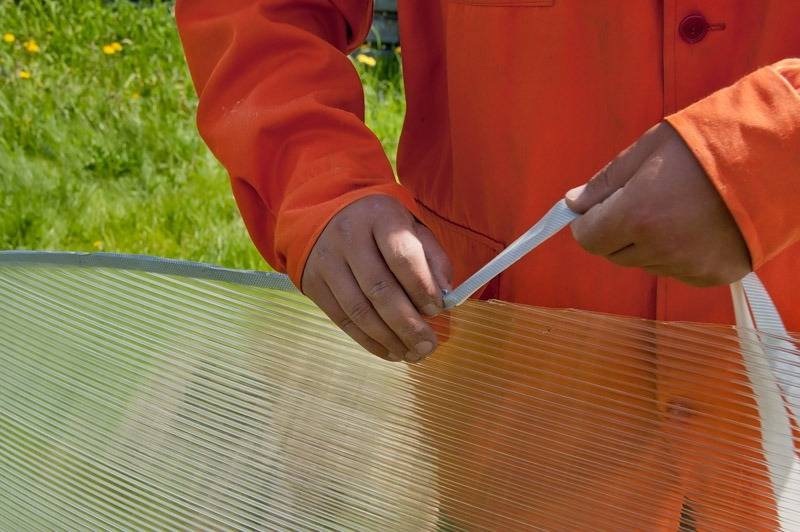
- set the end profile along the bottom edge;
- orient the sheet outward with a UV layer that protects the polymer from ultraviolet radiation, lamination, as a rule, is marked by the manufacturer.
Fastening of polycarbonate to the frame is performed by:
- self-tapping screws and bolts with thermal washers;
- special polymer or aluminum profiles;
- galvanized steel strips.
The sequence of work when attaching plastic to a metal frame from a 40x60 mm profile:
- Apply a sealing tape to the top surface of the steel structure.
- Apply the edges of two sheets of polycarbonate to the bearing profile, observing a gap of 8-10 mm.
- Bend back the protective film from the edges of the panels, mount an aluminum profile with sealing contours on top of the joint. They are inserted independently into the grooves provided for this.
- Holes with a depth of at least 36 mm are drilled through the aluminum profile, self-tapping screws are screwed in with a pitch of 500 mm.
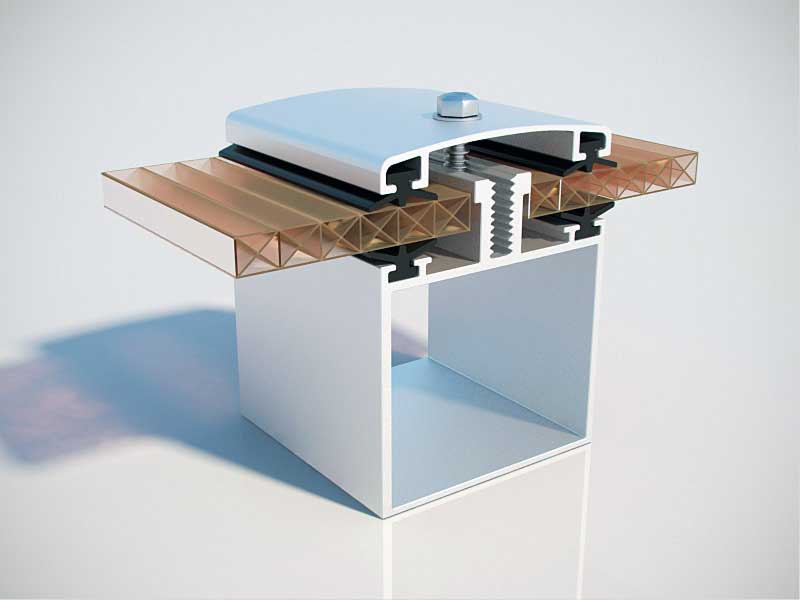
With this fixing, cellular polycarbonate is not drilled. Seals create a reliable barrier against moisture penetration, compensate for thermal deformations of the polymer in the unit.
Choosing a place and base material
The material for making the base of a polycarbonate gazebo can be wood, metal or stone. Variants with other types of materials are possible, but these three are the most commonly used.
Each of them has both a number of advantages and certain disadvantages.
- Wooden frames are made from timber. This is quite affordable and inexpensive material. Its indisputable advantage is environmental friendliness, naturalness. In addition, the wood has a beautiful natural structure. The disadvantages of this design include fragility, instability to weather conditions and the complexity of maintenance.
- The metal base is a frame made of a profile or corner. Such arbors are very durable, reliable, and have a long service life. But they also have their disadvantages: high cost, complexity of assembly, requiring the use of welding.
- Stone frames are made of natural stone, brick, concrete. Stone foundations will last a very long time, in addition, they are distinguished by their naturalness and aesthetic appeal. Moreover, they are quite heavy, their construction will require a lot of time, and replacement will create a lot of difficulties.
It is best to choose a flat, dry surface. Ideally, if it will be located somewhat on a hill, so that moisture from precipitation does not collect in the area of \ u200b \ u200bthe construction. Choose a shady, draft-free location. It will be convenient if the building is located as close to the house as possible. If there is a pond, then it is good to put a gazebo near it, this will give additional freshness and coolness in times of summer heat.

Step-by-step instruction
When choosing a place in the garden for building a shed, it is necessary to take into account the presence of irregularities and slopes on the surface of the earth. It is recommended to carefully level the site before starting construction.
Also pay attention to wind speed and direction. An open arched alcove, which will be constantly blown by the wind, is unsuitable for its intended use
For this reason, try to cover the structure with a wall, fence, or even plants. It should be noted that the proximity of dense bushes and tall trees negatively affects the technical characteristics of polycarbonate. With strong gusts of wind, the branches of the plants scratch the roof of the building.
A garden gazebo that will be used as a summer kitchen should be close to the house. The close location of the summer cottage and the arbor will allow you to arrange family tea and dinners in the fresh air.
The frame of the structure can be made of wood or metal. Wooden beams and boards are prone to rotting, therefore, they require periodic treatment with antiseptics and fire retardants. Iron is strong, reliable and durable. It is possible to prevent the appearance of rust on the surface of a metal profile by treating it with special anti-corrosion agents.
In the process of erecting a canopy from a metal profile and a polycarbonate coating, you will need the following tools and materials:
- polycarbonate sheets;
- hermetic tape for processing the end face of polymer plastic;
- self-tapping screws and thermal washers;
- steel pipes with a diameter of 50 mm for the manufacture of supports;
- metal corner with a size of 40x40 mm for the manufacture of rafters, strapping and frame fencing;
- metal screws and brackets;
- electric jigsaw, hacksaw or polymer saw;
- building level, twine and wooden pegs;
- soil drill and hammer;
- container for mixing concrete, shovel;
- screwdriver, electric drill with attachments of various diameters;
- pliers;
- hacksaw for metal;
- welding machine, grinder.
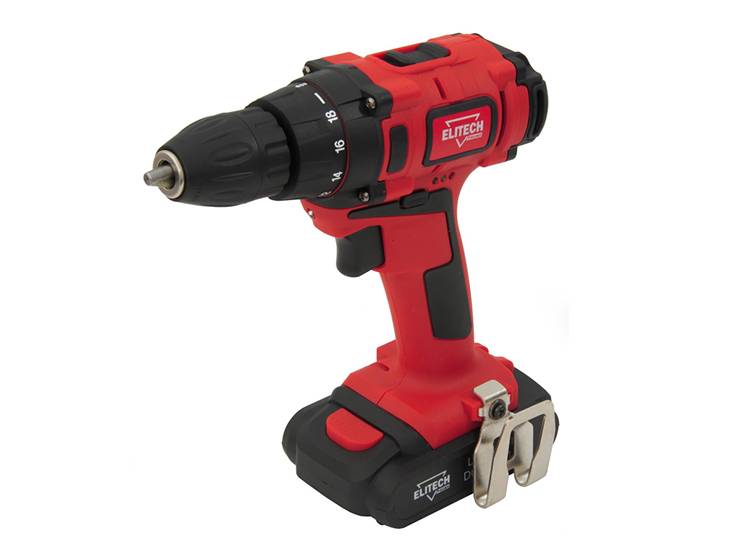 To create a gazebo, you need a tool
To create a gazebo, you need a tool
Measurements and calculations
The preparatory stage for the construction of a summer cottage provides for the development of a drawing plan. A well-thought-out scheme will help you make the right calculations and avoid common mistakes during construction. You can draw up a drawing yourself. To do this, you need to draw a sketch of the future structure, calculate its dimensions and select the material.
In the absence of drawing skills, it is recommended to seek help from specialists who will help build a drawing and draw up a detailed plan for the construction of the project.
Foundation
The construction of a stationary gazebo in the courtyard of the personal plot begins with marking the site and pouring the foundation:
- Clear your garden area of plants and other debris. Level the pad.
- Determine the first corner of the wireframe. Place a wooden peg in this place.
- Use a spirit level to mark the other three corners of the canopy. Stretch the twine by connecting four points around the perimeter.
- Dig a pit 25–30 cm deep. Tamp the soil and check the horizontal and vertical lines are even. Fill the hole with sand and rubble.
- Using a soil drill, drill holes in the corners with a depth of 70–100 cm. Now you need to install, fix and concrete the metal support pipes. Strut the supports.
- Weld metal corners to the supports.
Frame
It is not difficult to assemble the metal frame of the garden alcove if you follow the step-by-step instructions:
- Weld the crossbars to the support posts.
- Make the top strapping of the frame. Test it for strength.
- Assemble the rafters and other floor slabs on the ground. Lift the welded structure up and weld the roof to the pillars.
- Treat the metal profile with anti-corrosion agents.
Glazing
At the last stage of assembling the garden gazebo, you need to cover the structure with polycarbonate.
Polycarbonate sheets are cut on a flat horizontal surface. Then you need to process the ends of the canvas with a sealed tape. When covering the frame, leave a small gap for thermal expansion of the canvas. You need to work with polycarbonate carefully and accurately.
Do not remove the protective film from the surface of the panels until the glazing of the structure frame is completed. Otherwise, scratches and cracks may remain on the polycarbonate.
Construction of structures: first steps
A gazebo for a summer residence made of polycarbonate is made open or closed. Use material for walls and partitions - you will erase the visual boundaries between the pavilion and the beauty of the surrounding landscape. It is necessary to start work with the design of the location of the product.
Where to put the arbor?
The low weight of the structure ensures its stability on any soil. Experts recommend choosing a place for garden gazebos made of cellular polycarbonate as follows:
- place the structure next to the house or build a long visor that will connect the adjoining part with the pavilion;
- an excellent solution - a flat and dry area in an elevated place;
- it is preferable to install the product near a pond or in the shade of trees. This will slightly reduce the influence of the sun's rays, which are attracted by the honeycomb material.
Make a drawing of the simplest product with an arched roof, taking into account the standard parameters of a honeycomb (2.1x6 m) or monolithic (2.05x3.05 m) material.In the diagram, take into account the direction of the wind, uneven ground, the type of building and its total weight.
How to choose the type of arbor?
There are many options for beautiful polycarbonate gazebos that will please the owners of country houses:
- there are open and closed buildings depending on the presence of walls. The first type of garden pavilions made of polycarbonate will create the effect of unity with nature, and the second will protect from rain;
- according to the method of installation, the products are stationary and portable. Mobile devices will allow you to play with landscape design, and a stationary gazebo with your own hands requires a reliable foundation;
- the complexity of the design determines the configuration of the polycarbonate canopy for the gazebo - on support pillars or fancy.
You can equip the product with a barbecue, barbecue or leave it in its original form.
Pavilion design ideas
Any little thing can affect the style of a stylish gazebo made of cellular or solid polycarbonate intended for giving. The design idea will be a photo from the Internet, but you can use ready-made options:
- Create an eye-catching corrugated polycarbonate canopy. Keep it in a trendy eco-style by building a frame made of wood;
- play with the drawing, choosing the unusual shape of the arbor - place one sheet close to the ground, and leave the other unclosed;
- a domed greenhouse with open walls is a great opportunity to relax in ecologically clean and comfortable conditions;
- profile and polycarbonate structures for a classic look. It will be a little pretentious, but solemn solution for a site in a landscape or Versailles style;
- connoisseurs of maximum comfort will like the arched structures with glazing, pavilions near the pools, complemented by forging or a domed roof.
Build an extension to your house by making a canopy out of polycarbonate for your gazebo in the form of a roof extension. Organize an exit from the inner part of the yard. In such a gazebo it will be warm even in winter.
Material selection
In order for a do-it-yourself polycarbonate gazebo to be built technologically correctly, consider the following material selection criteria:
- The width of the honeycomb or monolithic sheet. In the first case, this indicator is 2.10 m, and in the second - 2.05 m.
- The length of the profiles. Monolithic ones are available in lengths up to 6 m, and cellular polycarbonate plastic - up to 12 m. Cutting of plates can be ordered from the manufacturer.
- Translucency. The throughput of a monolithic type of material is higher, and the cellular one transmits 88% of the rays.
- Insulation indicators. The cellular type of polycarbonate has a higher level of noise and heat insulation.
Both types of polymer plates have traumatic edges, do not crack or chip. Practical gazebos and sturdy canopies made of various polycarbonates can be functional or decorative.
We select the frame
To make a polycarbonate gazebo with your own hands, you need to decide on the type of supporting frame. Wood and metal are popular flooring materials for polycarbonate sheets. Metal parts will be strong, reliable, but wood is easier to assemble. During operation, the structure requires maintenance: the metal is periodically painted, and the wood is treated with anti-rot impregnation.
What kind of roof can be built
Mono-pitched
The simplest, cheapest and most popular option. The gazebo is covered with several sheets that are tilted to the roof and provide reliable and practical protection.
This option is far from those aesthetic architectural masterpieces of expensive gazebos, but it is quite applicable to almost any building.
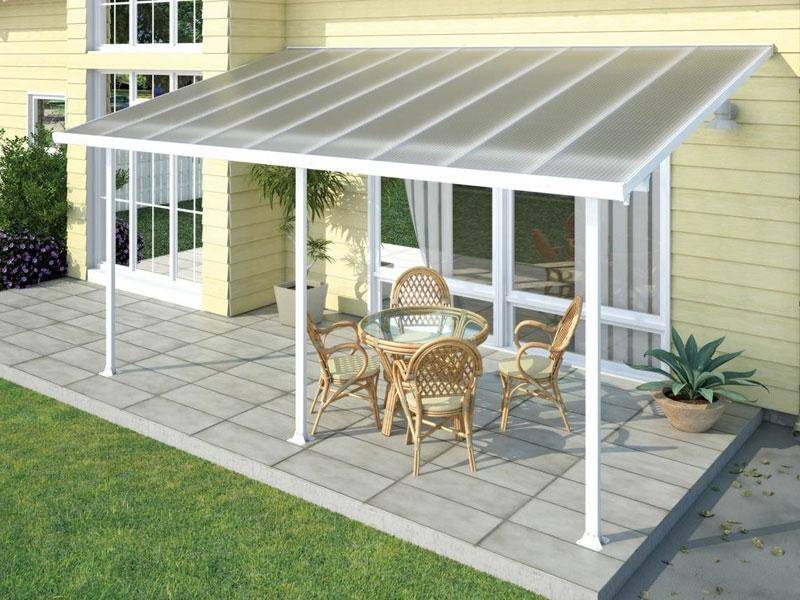 Single slope option
Single slope option
Gable
A relatively simple structure, which will not be difficult to build on your own
It will be important to correctly select the angle of inclination on both sides, which should be at least 6 degrees, so that the whole structure looks harmonious
 Gable
Gable
Chetyrekhskatnaya
This option is of a more complex type. You will have to invest a lot of time in the analysis of the structure and the installation of sheets on the rafter system.
The process of erecting a more "steep" - hip roof looks even more complicated, but possible. If you follow the instructions and do not skimp on materials and quality of construction, then everything will turn out in the best way.
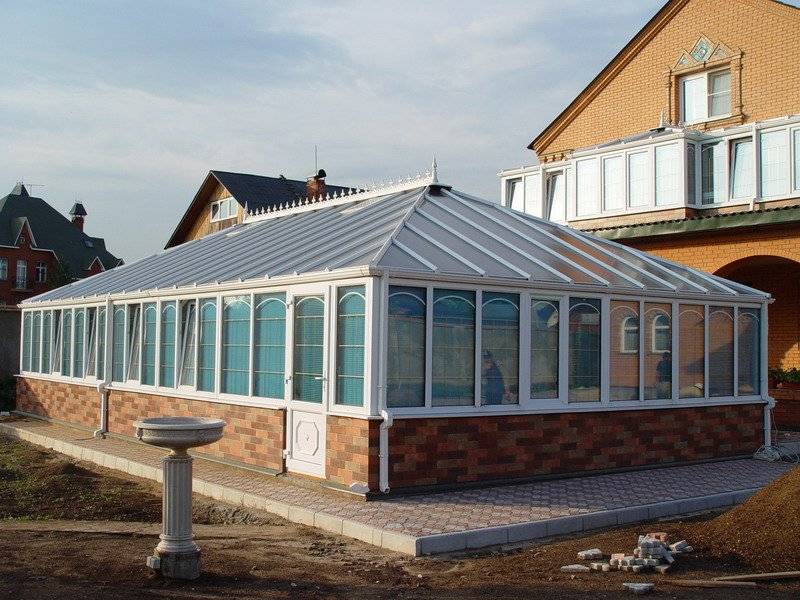 Chetyrekhskatnaya
Chetyrekhskatnaya
Hexagonal
In this case, there are already difficulties with the polycarbonate itself, which must be correctly measured and cut. There will be problems with the construction of the roof, since it will be difficult to make it even on all edges (but it is possible!).
A similar option is also implemented by hand without any special knowledge and experience.
 Hex (hexagonal)
Hex (hexagonal)
Arched
In the case of an arched shape, you will have to bend the polycarbonate to attach it to the rafters.
Here it is important to understand the specifics of polycarbonate - it gains the greatest rigidity when it bends downward in honeycombs, and besides, condensate does not accumulate in them due to this direction. Otherwise, when bending, you can corny ruin the material.
 Arched
Arched
Dome (round)
The pinnacle of architectural thought in this publication is the domed shape of the carbonate roof. Few summer residents venture into such a roof format, since this process is rather complicated and risky.
Nevertheless, if you nevertheless decide to sculpt such a shape out of polycarbonate, follow the instructions of experienced builders, otherwise by the end of construction you will not have any roof or building material :).
 Dome blue
Dome blue
Examples of beautiful polycarbonate gazebos
Polycarbonate is a flexible and affordable building material, excellent options for arbors are obtained from it. Aesthetics and beauty are felt in them. This material comes as an addition to the main annex, not as a base. This can be a roof overlap, partitions, or just a shelter.

Small gazebo with a semicircular polycarbonate roof on a log base

Compact gazebo with a gable roof for outdoor dining
There are many options for building. One of the simplest and most popular are awnings. This is just a roof on the pillars of the support, which can act as a main element, and as an addition to the house, as an extension.

A very original solution - a polycarbonate canopy, placed on gabion posts

Geological dome shaped polycarbonate garden gazebo
To make the structure more monumental, impressive, it is made on a rafter system. Arbors with decorative forging are another option that is considered not only expensive, but also impressive, of high quality. Polycarbonate practically protects the entire structure from bad weather.

Beautiful gazebo made of forged metal with a roof of the original shape

Quite a simple gazebo on a frame made of a profile pipe
The shape can be different: multifaceted, round, square, arched - everything to your taste and budget. To add zest to your design, polycarbonate can be chosen in different colors - it looks very beautiful and aesthetically pleasing. If your home is designed in a classic style, a bronze shade is perfect.
Variety of designs of polycarbonate gazebos
The fact that polycarbonate structures can be given various configurations makes it possible to translate any idea into reality. It can be a simple construction of two benches and a table in the middle, with a semicircular polycarbonate cover. Such a mini-gazebo made of a profile pipe and plastic can be transferred to any place in the garden or yard.
 The original round-shaped gazebo made of polycarbonate.
The original round-shaped gazebo made of polycarbonate.
For those who prefer closed models, various options for arbors are offered, where transparent polycarbonate sheets are used for partitions.In such a gazebo, you can hide from the wind and rain, and by choosing yellow or orange to cover, you can create the illusion of sunlight inside the room, despite inclement weather.
On a note! When using a polycarbonate coating in the construction of a gazebo, use a thermal washer to match the color of the material. This will make the point attachment almost invisible and give the product an aesthetic appearance.
 The gazebo is built of metal profiles and polycarbonate.
The gazebo is built of metal profiles and polycarbonate.
Gazebos made of profile and polycarbonate in the shape of a hemisphere with sliding doors along the guides look very impressive. Such a structure allows you to contemplate the suburban landscape from any side. Being in solitude, at the same time, you are not deprived of the opportunity to observe what is happening around. Forged structures with a polycarbonate coating stand out for the ideal combination. They can be hexagonal or octagonal in shape, having an unsurpassed solemn look. Such gazebos are often performed when there is no need to save square meters of territory for recreation.
 There is a small wooden podium for the gazebo.
There is a small wooden podium for the gazebo.
The transparency of the polycarbonate roof allows you to place flowerpots and pots with your favorite flowers inside the gazebo. They will receive enough sunlight for development and at the same time will be deprived of the harmful effects of ultraviolet radiation.
If wooden elements prevail in the accents of the exterior, you can freely combine polycarbonate with wood. Moreover, the models of such structures can be unpredictable themselves and resemble in shape a horse-drawn carriage or a children's swing-rocking chair under the roof.
 Polycarbonate protects the guests in the gazebo from UV radiation.
Polycarbonate protects the guests in the gazebo from UV radiation.
A separate group can include polycarbonate gazebos with an arch-shaped roof. Most often, such structures are used in the form of light sheds attached to the house. Polycarbonate in such structures can act immediately as a roof and walls. Design solutions for gazebos with a roof made on several levels are very interesting. These are more complex designs. And it would be reasonable to order a ready-made polycarbonate gazebo for a summer residence. Photos and the price of products can be seen in the price lists of the manufacturers.
